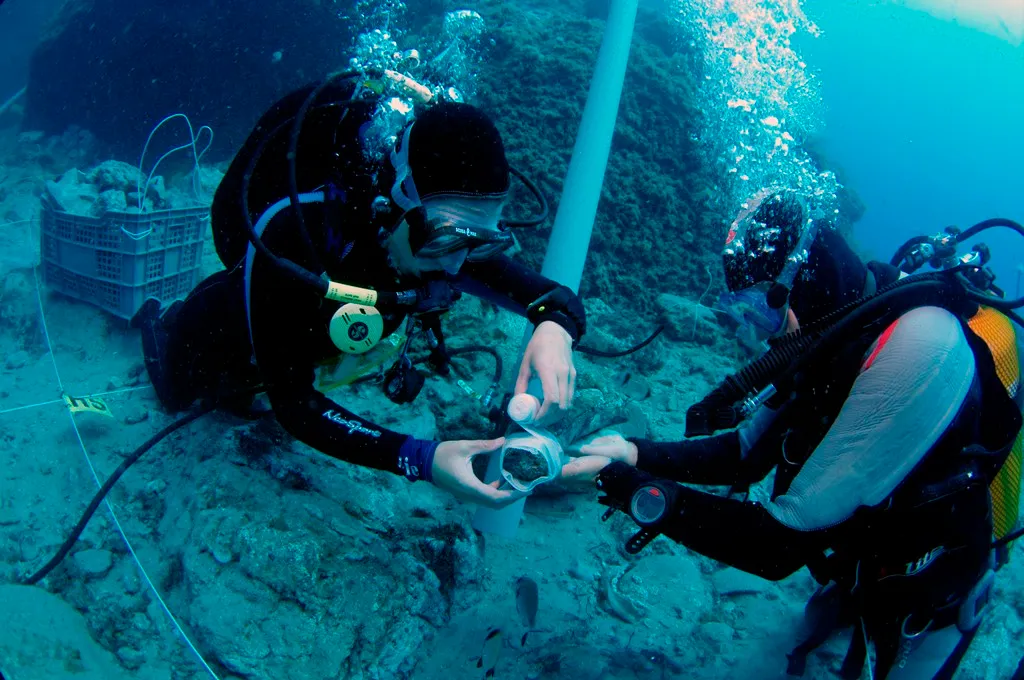Marine archaeology, an upcoming field of study, promises to deliver intriguing findings from the past, submerged in water bodies such as seas and oceans.
Marine archaeology, an upcoming field of study, promises to deliver intriguing findings from the past, submerged in water bodies such as seas and oceans. Marine archaeology or the exploration of the past sunk in the seabed or the oceans, is the recent and emerging source of understanding the rich culture that we cradled. The discoveries so far cover a vast period of more than 5,000 years, documented by scholars of present times when they started peeping into the evidence buried under the water. These include coastal settlements that got submerged with the rising sea-levels, the cargo along with the sunken vessels of the traders, seafarers, pirates, warring navies, their arms and tools, anchors and much more. The documentation and subsequent reconstruction of the past, the reliving the life and cultural traditions that these times would have enjoyed, the beliefs and practices, and the science and myths they harnessed – all become a part of the marine archaeology.
It was in 1981 that the National Institute of Oceanography was established in India. An autonomous body under CSIR, and headquartered in Goa, with three regional centers at Mumbai, Kochi and Vishakhapatnam, it was mainly to support sustained inter-disciplinary oceanographic studies. The initial pioneering studies by S.R. Rao and others led to the discovery of Bet Dwarka and the port city of Lothal. They applied the multi-disciplinary approach, including thermoluminescence techniques on the potteries for an accurate dating.
We have come a long way since then. Several coastal excavations have been carried out in Lakshadweep, Mahabalipuram, Poompuhar, Vijaydurg, Rameshwaram, Kalingapatnam, Mangalore, Ratnagiri, Dhobal, Janjira, Beypore, Honnavar, Bhatkal, Chilika, Gulf of Khambhat, etc. Since the establishment of Centre for Underwater Studies in 1983 at the Tamil University, Thanjavur by the University Grants Commission, many universities like Banaras Hindu University; Andhra University, Vishakhapatnam; Department of Coastal Disaster Management, Pondicherry University; Veer Narmad South Gujarat University, Surat; Annamalai University, Anna Nagar, Tamil Nadu; Cochin University of Science and Technology, Cochin, Kerala and privately funded initiatives have come up to fill this fascinating segment of unexplored knowledge. This is besides the Archaeological Survey of India, who have their own marine archaeology wing and have carried out significant explorations independently. Help and engagement with the expertise of Indian Navy, particularly the INS Darshak for explorations in Bay of Bengal is well known. India is also a signatory to the 2001 Convention on the Protection of the Underwater Cultural Heritage of UNESCO.
While ocean archaeology derives support from literary and other on-land sources, it also extends strength to the descriptions found in the records and even paintings. For example, the paintings of Ajanta give us a visual display of the boats and vessels used for voyages during the period, and similar findings of the wrecks under the sea help us establish the antiquity of the objects. Literary sources and accounts of travellers give us the accounts of the travels undertaken, but shipwrecks, coins, and other submerged finds establish the exact routes undertaken for such voyages.
Self-contained underwater breathing apparatus or SCUBA is the most common tool used by amateur under water archaeology enthusiasts. However, several advanced techniques using state-of-the-art cameras and Surface Demand Diving System and Aquazepp or underwater scooters provide vital support to the researchers. Use of good quality side scan sonar can give an insight into the submerged artifacts as deep as up to 500 meters. It helps in reconstructing the ground plans of the submerged sites. Patterns generated by echo sounder, and echogram help in both, locating the submerged objects like structures, shipwrecks and artifacts and profiling their shape, without endangering the surrounding sea-life.
State-of-the-art side-angle and macro lenses, especially suitable for the underwater photography are now available to us. Besides, stratigraphy techniques such as airlift also help significantly in exploring the buried antiquities.
While Dwarka, Somnath and Bet Dwarka have been widely documented, there is a lot to be explored on the eastern coast of the peninsula, which has been a very popular sea highway to Southeast Asia. The findings of Poompuhar, the port town on the mouth of river Kaveri, establish its rich legacy as a port town more than 2,300 years old. The early Sangam literature finds its mentions and gives sufficient details which are corroborated by the findings of the ocean archaeology. Similar explorations around the rich coastal line along the Bay of Bengal may unravel fascinating details about the hidden cultural treasures of the seabed.
Similarly, perhaps the Lakshadweep archipelago, which lies at the cross-roads of the marine route from India to North Africa and to West Asia. There have been encouraging findings of the antiquities of the Buddhist period, and with immense promise of much more. Perhaps with the opening of the tourist interest in the islands, gradually, a more systematic study of ocean archaeology might also pick up.
India has a vast coastal boundary. Spread over 7500 kilometers, it covers 13 states. The nation also comprises of the group of islands of Andamans, Nicobar and Lakshadweep. This adds to an additional stretch making our coastal zone almost 15,000 kilometers. The linkages of the mainland with the neighbouring countries using the sea route are well known and may also have existed during the pre-ice age. We have ample evidence of seafaring and ships etched on the bas reliefs of Angkor Wat, considered to be an extension of the Indian culture. As the newer technologies emerge, so do the new studies. Ocean archaeology is still in the nascent stage and holds immense promise for knowing our heritage closely.

